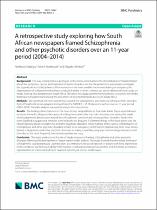| dc.contributor.author | Masinga, Nombuso | |
| dc.contributor.author | Nyamaruze, Patrick | |
| dc.contributor.author | Akintola, Olagoke | |
| dc.date.accessioned | 2022-11-10T07:49:33Z | |
| dc.date.available | 2022-11-10T07:49:33Z | |
| dc.date.issued | 2022 | |
| dc.identifier.citation | Masinga, N. et al. (2022). A retrospective study exploring how South African newspapers framed Schizophrenia and other psychotic disorders over an 11-year period (2004–2014). BMC Psychiatry, 22(1), art. no. 667. https://doi.org/10.1186/s12888-022-04276-5 | en_US |
| dc.identifier.issn | 1471-244X | |
| dc.identifier.uri | https://doi.org/10.1186/s12888-022-04276-5 | |
| dc.identifier.uri | http://hdl.handle.net/10566/8158 | |
| dc.description.abstract | The way schizophrenia is portrayed in the media contributes to the dissemination of misinformation
about the symptoms, causes, and treatment of mental disorders and has the potential to perpetuate or mitigate
the stigmatization of schizophrenia. While research on the news media’s role in exacerbating or mitigating the
stigmatization of schizophrenia has been conducted widely in other contexts, our search did not yield any study on
media framing of schizophrenia in South Africa. Therefore, this study used the framing theory to examine the media
framing of schizophrenia following the enactment of two mental health policies in South Africa. | en_US |
| dc.language.iso | en | en_US |
| dc.publisher | BMC | en_US |
| dc.subject | Public health | en_US |
| dc.subject | Mental health care | en_US |
| dc.subject | Schizophrenia | en_US |
| dc.subject | Mental disorder | en_US |
| dc.subject | South Africa | en_US |
| dc.title | A retrospective study exploring how South African newspapers framed Schizophrenia and other psychotic disorders over an 11-year period (2004–2014) | en_US |
| dc.type | Article | en_US |

